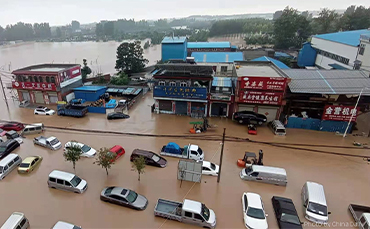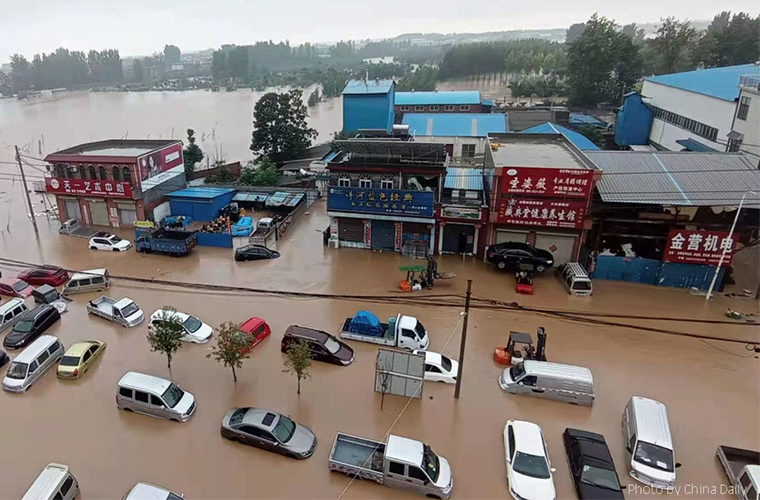



▲ An aerial view of flooded village in Hui County, Xinxiang City, Henan Province in July, 2021. [Photo/China Daily]
3. Main Tasks.
3.3 Enhance the climate change adaptation capacity of cities.
Conduct extensive training on climate change adaptation knowledge and skills, carry out publicity activities on climate change adaptation themes, and raise public awareness of climate risk prevention and climate change adaptation concepts. Incorporate climate change adaptation-related content into the construction of national ecological and environment science popularization bases. Promote the popularization and application of advanced technologies for climate change adaptation. Strengthen international cooperation on climate change adaptation, engage in international exchanges of policies, technologies, and practical experiences in the construction of climate-resilient cities, and foster the establishment of partnerships between climate-resilient cities.
3.4 Strengthen early warning, monitoring, and emergency management systems for extreme weather and climate events.
Build a comprehensive urban meteorological observation system based on ground-based automatic weather stations. Establish a monitoring and early warning system for meteorological disasters and secondary disasters. Develop an early warning platform and sub-disaster monitoring, forecasting, and warning system, and establish a disaster database for extreme weather and climate events. Establish a regular management system for cross-departmental and cross-regional joint prevention and control, formulate and improve emergency plans for extreme weather and climate events, and enhance the response mechanism for emergency and disaster relief. Strengthen the deployment of professional emergency rescue equipment and optimize the layout of storage pools for emergency supplies.
3.5 Optimize the spatial layout of climate-resilient cities.
Strengthen the assessment of climate risk and resilience in the implementation evaluation of territorial spatial planning. In conjunction with the formulation and implementation of territorial spatial planning, further explore spatial strategies for urban climate change adaptation and optimize the spatial layout of cities on the basis of the “three areas and three limit lines” (i.e. “three areas” are agricultural, ecological and urban areas, “three limit lines” are permanent farmland protection red line, ecological protection red line, and urban development boundary.) and the blue and green lines. Integrate urban planning and land policies and coordinate the comprehensive utilization of urban aboveground and underground spaces. Delineate marine disaster prevention and control zones and flood risk control lines, and enhance the regulation of urban and regional water spaces. Determine control zones for important infrastructure land and reserve development spaces, while improving urban resilience spaces and infrastructure, and establish an urban safety defense system with communities as the basic units.
3.6 Enhance the climate resilience of urban infrastructure.
Establish and improve the infrastructure archiving system, accelerate urban municipal infrastructure surveys, propose targeted measures to enhance infrastructure resilience, and incorporate them into municipal infrastructure construction planning and implementation plans. Encourage the exploration of urban infrastructure stress tests. Comprehensively enhance disaster prevention, mitigation, resistance, emergency and disaster relief response capabilities of various urban infrastructures under extreme weather and climate events, as well as the capability of rapid recovery of vital urban infrastructure and comprehensive protection of key parts.
3.7 Enhance the capability to safeguard urban water security.
Integrate basin flood control with urban flood control and drainage, as well as the urban flood control with waterlogging management, speed up the implementation of urban flood control upgrading projects, build and improve the drainage and flood control system, effectively respond to rainfall within the standard of urban flood prevention and control, and strengthen the treatment of easily flooded places to implement the construction concept of sponge cities. Rationally improve the urban river flood control safety standards and flood control engineering standards to cope with extreme floods, storm surges, and typhoon disasters. Strengthen the protection of urban water sources, build backup water sources for emergency water supply, and effectively respond to water supply risks such as drought and water pollution.
3.8 Ensure safe operation of urban transportation.
Strengthen the comprehensive emergency coordination mechanism on early warning of extreme weather and climate events and of the urban integrated transportation system. Improve urban emergency corridor networks, upgrade urban road lighting, signage, and warning systems, and enhance disaster prevention and relief response capabilities during extreme weather and climate events. Actively prevent secondary geological disasters caused by extreme weather and climate events and implement flood and typhoon prevention measures for ports, harbors, waterways, and related facilities. Raise the threshold for urban road tolerance to climate change impacts, and formulate or revise relevant construction, management, and maintenance standards.
3.9 Improve the service of the urban ecosystem.
Conduct a composite ecological network intertwined with water networks and green spaces and create a continuous, intact, and functional urban ecological security barrier to build an urban space and landscape pattern that is integrated with climate change adaptation. Implement urban ecological restoration projects, strengthen soil and water conservation in cities, strictly protect critical urban ecosystems, and fully utilize the disaster mitigation function of ecosystems. Integrate biodiversity protection requirements into the relevant standards and specifications in terms of urban planning, construction, and governance, and encourage the restoration and construction of native ecological environments through the use of street, small-scale spaces of communities. Improve urban ecosystems and enhance urban biological carbon sink capacity to promote green development in urbanized areas.
3.10 Advance the urban climate change health adaptation actions.
Carry out monitoring and assessments of urban climate change health risks, identify key climate-sensitive infectious diseases and chronic non-communicable diseases in the city, and implement urban climate change health adaptation actions. Establish an early warning and intervention mechanism for climate-sensitive diseases, heatwaves, and other health risks, and issue warning signals and health advisories promptly.
Source:<https://www.gov.cn/zhengce/zhengceku/202308/content_6900892.htm>
<https://language.chinadaily.com.cn/a/202203/16/WS6231a844a310fd2b29e51501.html>
Edited and Translated by Guo Xinxin